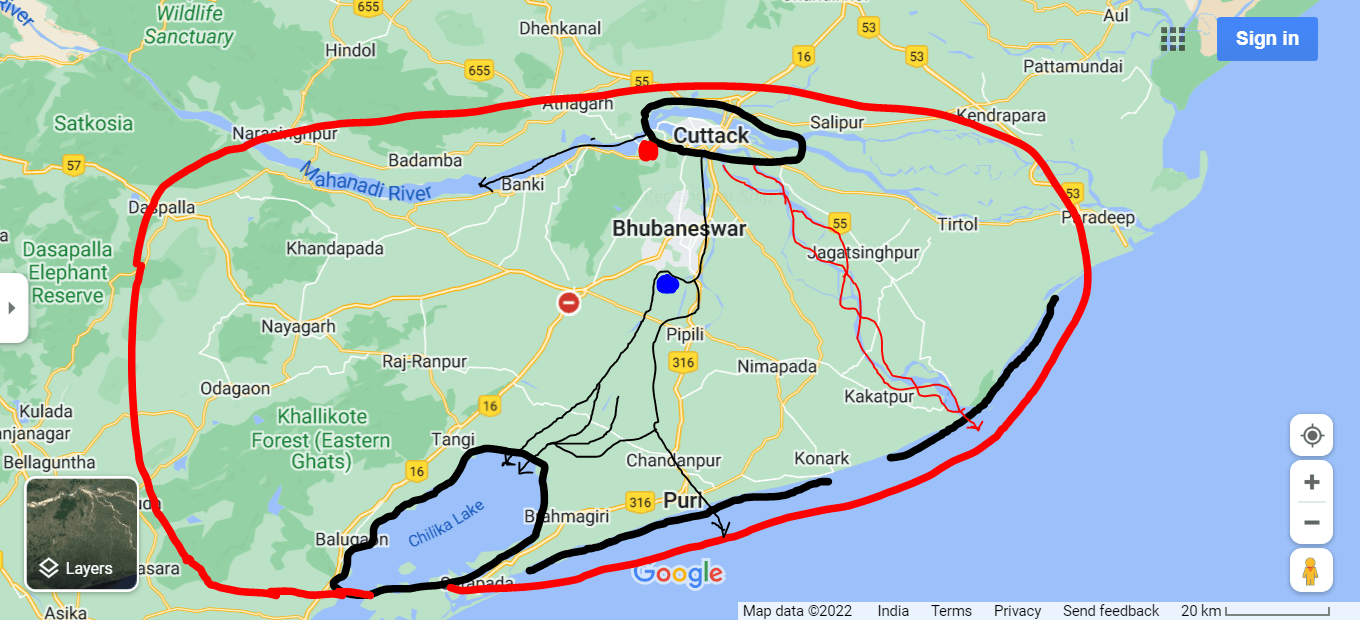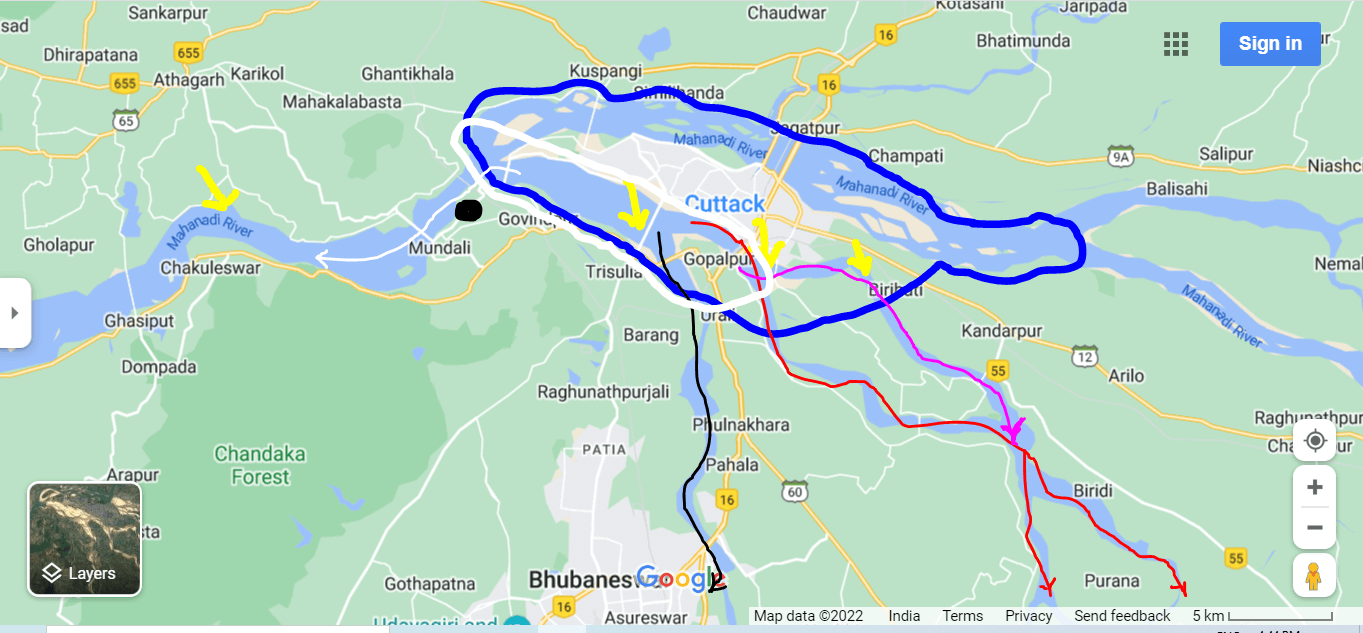The Ancient Indian Texts talk about four Samudras, not four Oceans (4 oceans in the Vedas). The meaning of Samudra in those texts is “large waterbody.” Thus, Samudra could mean freshwater lake, saltwater lake, riverine lake (at the river-knee), sea, or ocean.
The most famous Samudra of the ancient texts is Kshira Samudra. Very often, it is addressed as Samudra only.
The synonyms of Samudra were Sindhu, Sagara, Saras, Pushkara, Kunda, etc.
It dawned upon us recently that the Puranic Ancient India or Puranic Jambudvipa-Bharatavarsha-Aryavarta was limited to a small portion of Present India/ Present Bharatavarsha.
Why are there 4 oceans in the Vedas?
It was a small tract of land lying between:
- Ancient Uttara Samudra (marked by Ancient Himavat).
- Ancient Dakshina Samudra.
- Ancient Purva Samudra.
- Ancient Paschima Samudra.
The first one, i.e., Uttara Samudra (wrongly translated as Northern Ocean), is a riverine lake formed at the belly of Ancient Ganga. The second one, i.e., Dakshina Samudra (exaggeratedly translated as the Southern Ocean), is a sea. The third one, i.e., Purva Samudra (exaggeratedly translated as Eastern Ocean), is a sea again. The fourth one, i.e., Paschima Samudra (wrongly translated as Western Ocean), is a saltwater lagoon.
The seat of Puranic Ancient India or the Puranic Bharatavasha has been identified as Odisha Central, a tract of land between Mahanadi River and Chillika Lake.
The Puranic Ganga has been identified as the Mahanadi River’s southeast-flowing major branch (Mahanadi-Kathajodi-Devi).
Ancient Bharatavarsha was watered by the Twin Rivers – Puranic Ganga and Puranic Sindhu and their distributaries.
The Ancient Sindhu was Mahanadi’s south-flowing major branch (Koyakhai-Bhargavi-Daya).
Now it is easy to identify the Ancient Four Samudras. Look at the image:

Four Samudras of Ancient Indian Texts: Uttara-Dakshina-Purva-Paschima Samudras:
(1) bold red circuit = Ancient India / Ancient Bharatavarsha = Modern Odisha Central
(2) red circular small patch (top, middle) = Ancient Mount Himavat-on-Ganga
(3) blue circular small patch (middle) = Ancient Mount Meru = Modern Dhauligiri Hill
(4) system of red lines = Ancient Ganga River = Modern Mahanadi-Kathajodi-Devi River
(5) system of black lines = Ancient Sindhu River = Modern Koyakhai-Bhargavi-Daya River
(6) bold black circuit (bottom) = Ancient Paschima Samudra = Modern Chillika Lake
(7) bold black circuit (top) = Ancient Uttara Samudra/ Ancient Kshira Samudra/ Lake Anavatapta (of Maha Prajnaparamita Shastra) = Modern Cuttack Water Encirclement/ Belly of Modern Mahanadi River
(8) bold black line (right, upper) = Ancient Purva Samudra = Modern Paradip Sea (Bengal Bay)
(9) bold black line (right, lower) = Ancient Dakshina Samudra = Modern Puri Sea (Bengal Bay)
(10) black lone arrowed line = Ancient Vakshu River (of Maha Prajnaparamita Shastra), imagined to be flowing westward from Lake Anavatapta to enter finally Paschima Samudra (to be explained later in this discussion)
…
How were these waterbodies named by incorporating a directional epithet? What was the reference point in doing so?
Mount Meru, standing at the center of Ancient India/ Puranic Bharatavarsha, was the reference point. Depending on their directional location concerning Mount Meru, Samudra’s were named Uttara, Dakshina, Purva, and Pashchima.
in Ancient Indian Texts, there are many occasions in which the Chatuh-Samudra (Four Samudras) are described. We quote a portion of Maha Prajnaparamita Shastra of Mahayana Buddhism as a corroborative narrative.
Question: In Jambudvīpa, there are many kinds of great rivers (MAHAANADI); some surpass even the Ganges. Why do you always use the expression ‘as numerous as the SANDS OF THE GANGES’ (gagaṇānadīvālukopama)?
Answer: 1) Because THE GANGES IS SANDIER THAN THE OTHER RIVERS. …
In JAMBUDVIPA, FOUR GREAT RIVERS come from the northern (uttarānta) boundaries and are EMPTY INTO THE OCEANS IN THE FOUR DIRECTIONS OF SPACE (caturdiśasamudra).
At the northern boundaries, in the Snowy Mountains (HIMAVAT), there is LAKE A na p’o ta to (ANAVATAPTA); in the lake, there is a lotus golden in color and made of the seven jewels (suvarṇavarṇānisaptaratnamayāni padmāni), as large as a chariot wheel. [Its master], Anavatapata, king of the nāgas (NAAGARAAJA), is an excellent bodhisattva of the seventh bhūmi.
At the four corners of the lake, there are four [mouths] from which the water flows out: i) at the east, the Elephant’s Mouth (Siang t’eou = hastimukha); ii) at the south, the Ox’s Mouth (Nieou t’eou = vṛṣabhamukha); iii) at the west, the Horse’s Mouth (Ma t’eou = aśvamukha); iv) at the north, the Lion’s Mouth (Che tseu t’eou = siṃhamukha).
a) In the east, the Elephant’s Mouth empties into the Heng (GANGAA). Its bed consists of GOLDEN SANDS (suvarānavālukā).
b) In the south, the Ox’s Mouth empties into the Sin t’eou (SINDHU). Its bed also consists of GOLDEN SAND.
c) In the west, the Horse’s Mouth empties into the P’o tch’a (VAKSHU). Its bed also consists of GOLDEN SAND.
d) In the north, Lion’s Mouth empties into the Sseu t’o (SEETAA). Its bed also consists of GOLDEN SAND.
These four rivers all come from the mountain in the north. The GANGAA comes from the hill in the north and EMPTIES INTO THE EASTERN OCEAN (PURVASAMUDRA).
The SINDHU comes from the mountain in the north and EMPTIES INTO THE SOUTHERN OCEAN (DAKSHINASAMUDRA).
The VAKSHU comes from the mountain in the north and EMPTIES INTO THE WESTERN OCEAN (PASHCHIMASAMUDRA).
The SEETAA comes from the mountain in the north and EMPTIES INTO THE NORTHERN OCEAN (UTTARASAMUDRA).
The Ganges is the most important of these four rivers; people come there from the four directions of space and consider it a sacred river. The sins (āpatti), stains (mala), and faults (pāpa) of those who bathe there are entirely removed. Since all people venerate and know this river, THE SANDS OF THE GANGES are taken as a comparison.
Finally, the other rivers change their name, vying with one another, but the Ganges keeps their name from generation to generation; this is why THE SANDS OF THE GANGES are taken for comparison and not the other rivers.
[[Maha Prajnaparamita Sastra (by Gelongma Karma Migme Chödrön): Act 1.7: Explanation of the parable ‘as numerous as the sands of the Ganges’ (parent: Chapter XIV: Emission of rays)]]
…
Comment:: You have to be very careful about the wrong or exaggerated translation of the keywords and note their correct meanings, such as Ocean = Samudra = large waterbody; Snowy Mountain = Cool Mountain = Himavat, etc.
This mythical description of an aspect of Real Ancient India, as shown in Maha Prajnaparamita Shastra, is depicted in the accompanying image:

Samudras of Maha Prajnaparamita Shastra:
(1) bold blue circuit = Ancient Kshira Samudra/ Lake Anavatapta = belly of Modern Mahanadi River/ Cuttack Water Encirclement
(2) bold white circuit = alternative-popular Ancient Kshira Samudra/ Lake Anavatapta = southern half of belly of Modern Mahanadi River/ southern half of Cuttack Water Encirclement
(3) arrowed red lines = Ancient Ganga River = Modern Mahanadi-Kathajodi-Devi River
(4) arrowed black line = Ancient Sindhu River = Modern Koyakhai-Bhargavi-Daya River
(5) arrowed white lines = Ancient Vakshu River = Pre-Samudra part of Modern Mahanadi
(6) arrowed purple lines = Ancient Seetaa River = Modern Northern Devi River (northern effluent of Kathajodi River)
(7) black circular patch (top, left) = Ancient Mount Himavat = Modern Siddheshvara Hill
…
Note the anomalies of the above narrative. Daya River, the western affluent of Koyakhai-Sindhu, has been interchanged with Vakshu because of their similar (western) flow direction.
The confusion about Seeta River and Uttarasamudra is removed when we take Himavat as the infallible mark of Uttarasamudra.
This much literal convolution is permissible in such an old text which has come down to us across several transliterations and translations.
These minor anomalies are compensated by mentioning their infallible mark of being “excessively sandy.”
Thus, the Puranic Description of the Four Samudras matches with the Mahayana-Buddhist Description of the same. Even the river names of both the instances match, though the name of the lake shifts from Samudra to Anavatapta.
The description of the Lake Anavatapta of Maha Prajnaparamita Shastra corresponds to that of Lake Sati of Nilamata Purana. The master of the Lake Sati, like that of Lake Anavatapta, was also a Nagaraja, Nila by name.
The narrative also confirms the identity of Mahanadi as the Ancient Ganga. Apart from other commensurable attributes between the two, there is even a mention of the term “Mahanadi” in the above narrative.
Description of Ganga Avatarana Myth of the Puranas match with Maha Prajnaparamita’s given scenario concerning the Central Waterbody, the Four Rivers, and the respective Four Samudras.
